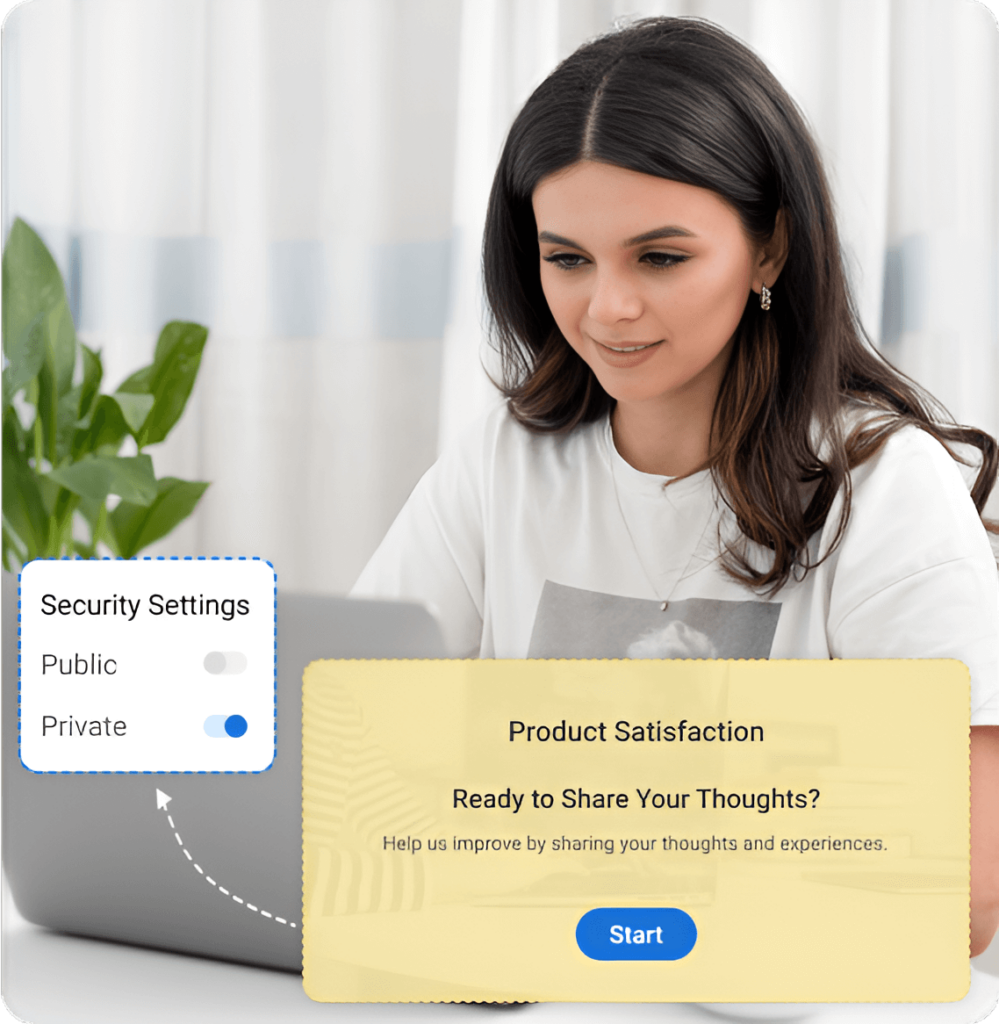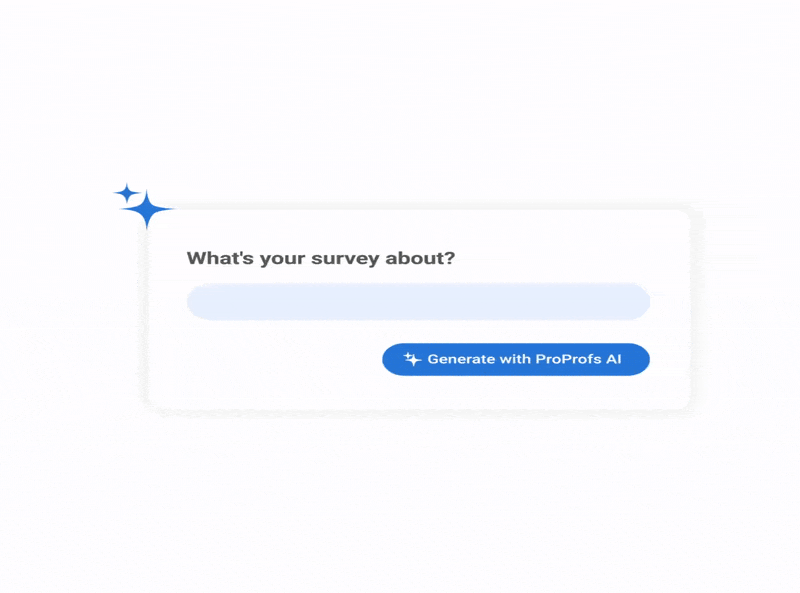Your customers hold the key to your business’ success. But this landscape is unpredictable, and understandably, trying to keep up can feel like chasing a moving target.
The only way for your business to stay afloat is by updating yourself and evolving alongside your audience.
That’s where online surveys come in. They’re your direct line to understanding what makes your customers tick.
But let’s be real – not all survey methods are created equal. In this post, we’ll weigh the advantages and disadvantages of online surveys to help you decide if they’re the right fit for your business.
What Is an Online Survey?
An online survey is a digital questionnaire used to gather information from a target audience. It’s essentially a virtual form filled out by respondents, providing data on their opinions, preferences, behaviors, and demographics.
These surveys can be shared through various channels, such as email, websites, or social media. They typically include a mix of question types, such as multiple-choice, rating scales, open-ended questions, and demographic information.
Unlike traditional paper surveys, online surveys offer several advantages, including faster data collection, lower costs, and the ability to reach a wider audience.
Think of online surveys as a digital conversation with your audience. They allow you to ask specific questions and listen attentively to their responses, providing valuable insights to guide your business decisions.What Are the Advantages of Online Surveys?
Gone are the days of tedious paper questionnaires and phone interviews. Online surveys have revolutionized how businesses connect with their customers – they’re faster, cheaper, and offer richer insights, along with many other significant advantages.
Let’s explore the benefits of going digital with surveys.
1. More Convenience & Better Responses
Online surveys give survey respondents the freedom to respond at their own pace, in their own space. They can start the survey whenever it’s convenient and take their time to think through each answer, leading to better, more thoughtful responses.
One reason many people skip survey handouts is that they have to complete them on the spot. Online surveys remove this pressure, which helps businesses get more honest and complete answers.
To further boost response rates, many businesses using ProProfs Survey Maker also send friendly follow-up reminders or place short surveys on thank-you pages or confirmation screens. These small tweaks often result in higher completion rates without overwhelming users.
2. Accessibility from Any Device
Turn back the clock two decades ago, and you see big clunky computers, a lot of paperwork, and not-so-smart phones. Now, we have phones, laptops, and tablets with powerful specifications that can put an old computer to shame.
Online surveys capitalize on this technological advancement, providing customers with the ease of use and flexibility they need to fill out survey forms. Respondents can access the survey form right away from their device, regardless of which device they use. Just send them the right link via email or text message.
Ease of accessibility again points to higher convenience and satisfaction, which further leads to quality responses.
3. Significant Cost-Cutting
Gone are the days when businesses had to break their bank accounts to conduct surveys across different geographic locations.
With the emergence of online surveys, things have changed for good. There is absolutely no expense in hiring an interviewer for telephone or in-person surveys, printing for paper-based surveys, and other related costs.
Since everything is online, you can create a survey and share them with your customers, even those living miles away, at half the cost. Just invest in an excellent survey maker tool, and you are good!
4. Flexible With Design
One of the notable advantages of surveys shared online is their design flexibility.
Web-based surveys are not set in stone, meaning you can mold them to fit your changing requirements. Long or short, complex or easy – online surveys can be designed just as you want. Set up skip logic and branching to provide a well-tailored survey experience. Branching is a great way to show questions based on respondents’ previous answers.
This means unimportant questions for a respondent will be skipped, and only valuable ones will be displayed, guaranteeing a smooth experience. Adding skip logic and branching to surveys make way for more relevant and insightful customer responses.
Additionally, you can customize your survey by giving it a logo, theme, and background color. An appealing design leaves a positive impact and instantly convinces customers to take your survey.
Watch how to customize & add branding to your surveys.
5. Allows You to be Selective
Not every question in every survey resonates with all your customers. If you distribute a single survey to your customers with varying problems, you will likely not get the correct responses.
Online surveys solve this with screening questions. You can ask a few quick questions at the start to filter respondents by demographics, interests, or experience. Businesses using ProProfs Survey Maker often rely on this to make sure only qualified participants continue. This reduces noise in your data and improves the overall quality of insights.
You can also use branching and skip logic to show only the most relevant questions to each respondent. That means less fatigue and more accurate answers, especially when your survey has multiple customer segments.
6. AI-Powered Data Analysis
Of all the advantages of online surveys, the most beneficial is the easy and quick data analysis. What used to take hours in the case of traditional paper-based surveys now is hardly a matter of minutes.
Data collection and in-depth analysis is a cakewalk regarding web-based surveys. If you have the right tool, you can easily view survey results in real-time and get access to valuable insights such as:
- Who took your survey, and when
- How people responded to your survey
- The total number of responses received weekly, monthly, and yearly, and a lot more.
Here’s a video on how you can track all this.
These AI-powered insights can set the right base for your future actions. You can instantly gain an in-depth understanding of your customers, spot trends, and make data-backed decisions.
For instance, a product manager at Intel used ProProfs Survey Maker to quickly gather customer feedback and make data-backed decisions with ease. The team found the tool intuitive and appreciated the prompt customer support during setup.

7. Maintains Respondent Anonymity
Another advantage of surveys shared online is the respondent anonymity they help you maintain. If you are looking for honest answers from respondents, this online survey feature is of tremendous help.
When customers learn about anonymity, they feel more free and comfortable voicing their concerns and giving true responses without inhibitions. Anonymous online surveys reward you with genuine and detailed answers that further help you make informed decisions.
Some of the best survey maker tools offer the option of keeping surveys anonymous, which is great for those who wish to capture sensitive information that customers would otherwise think twice about sharing.
8. Secure data handling and compliance

When collecting customer data, security isn’t just important, it’s a legal and ethical responsibility. Good online survey tools, like ProProfs Survey Maker, come with built-in security features such as SSL encryption, role-based access, and secure servers to protect responses from unauthorized access.
They also support data privacy laws like GDPR and CCPA. This means you can collect, store, and manage responses in a way that respects respondent rights and meets legal standards.
If you’re asking sensitive questions or collecting personal details, this level of protection builds trust and lowers the risk of non-compliance or data misuse.
9. Access to Accurate Feedback
It is common for customers to beat around the bush during in-person or telephonic surveys. Finding wheat from the chaff is another challenging and time-consuming process in such surveys.
Well, online surveys eliminate such problems. A key advantage of online surveys is that they allow you to design questions that help you obtain direct and accurate customer answers.
In addition, online surveys do not involve intermediaries such as interviewers or internal staff who capture customer data and then feed it into the system. With online surveys, the process of data collection and analysis is automated, ensuring zero errors.
10. Saves You Substantial Time & Effort

Unlike traditional surveys conducted in person or via phone, which require you to compile all the responses once the survey is complete, online surveys have no such hassles. They are easy to launch and even easier to analyze—you can do that right from your seat!
While launching online surveys takes just a few clicks, customers submit their responses in less than a few minutes. This saves time and effort on both sides.
Besides, since no printing and manual distribution is involved, you can create, publish, and analyze surveys using one integrated system – a big time-saver!
The California Department of Public Health used ProProfs Survey Maker to streamline feedback collection and automate certificate distribution, saving significant administrative time across departments.

11. Maximum Reach With Minimum Efforts
Thanks to the emergence of the internet, the world has become compact and connected despite its geographical boundaries. Owing to this, one of the most attention-grabbing benefits of online surveys is their heightened convenience.
For example, suppose a multinational company with a global customer base wanted to conduct a market research survey worldwide fifty years ago. In that case, it might have felt impossible, but today, such surveys are possible without much hassle.
With the right survey software, you can accomplish everything right from where you are!
12. Increased Customer Satisfaction
The ease, flexibility, and convenience provided by online surveys are unmatched. While online surveys allow you to share surveys with customers in seconds, they help your customers take up the survey right away or when they have the time to do so.
This gives you access to quick and quality responses that can further be decoded using a survey maker tool.
Online surveys keep you well-equipped and well-positioned to take immediate corrective actions to win back dissatisfied customers and turn the table in their favor.
When you act quickly based on feedback, customers feel heard and cared for and are likelier to stick with your organization. Here’s how you can create customer satisfaction surveys.
What Are the Disadvantages of Online Surveys?
While there are several advantages of online surveys, there are a few disadvantages as well. So, let’s go through the latter to gain more clarity around the problems you might encounter while working with online surveys.
1. Inability to Connect With People from Remote Areas
One of the major disadvantages of online surveys is their incompetence to reach people residing in far-off, remote locations with no access to the internet. Even elders who do not have internet access and are not proficient in working with online platforms are difficult to connect with using web-based surveys.
2. High Chances of Survey Fraud
In the case of lengthy, complicated, or confusing surveys, it’s highly likely for customers to skip questions and respond mindlessly just to get done with the survey. In many cases, people are tempted to complete the survey in exchange for a reward. Both these scenarios can lead to inaccurate responses and skewed results.
3. Sampling Issues
While conducting online surveys, watch for sampling issues that might impact the overall results. A representative sample is at the core of a survey that helps you generalize the results for a larger audience.
However, various sampling issues can hamper the effectiveness of online surveys. For example, a common sampling error occurs when researchers are confused about who to survey—those who directly use the product or those who influence the customers.
Another example is when only interested individuals participate in the survey out of their own will. The ideal process should involve researchers making extra efforts to get more people involved in the survey.
4. Response Bias
Another problem that can lead to misleading information is response bias in online surveys. Most of the time, people tend to respond in a certain way due to various reasons such as:
- The fear of being judged
- Financial situations
- Personality differences, and many others.
For example, in some surveys, customers might be inclined towards options that make them look more socially desirable and financially stable, thus leading to dishonest responses. Sometimes, even the order of survey questions can make people biased toward specific answers.
Another instance of survey bias is when participants are disengaged. As they have no interest in the survey, they tend to choose the last option of most questions, which again leads to unreliable results.
5. Survey Fatigue
Research conducted by Customer Thermometer found that the response rate for long surveys is a meager 9%. Yes, surveys can get tiresome, especially those with open-ended questions requiring deep and careful thinking.
Long surveys can take more than 10-15 minutes to complete. This induces fatigue in the respondents, resulting in dishonest responses or, even worse, survey dropout.
This clearly shows that long surveys or irrelevant questions are a big disadvantage and a major reason for customers disliking the entire process and, most often, abandoning the survey in between.
6. Increase in Errors
Since online surveys harness the power of technology, there could be many response errors. For example, internet connectivity can go low, forcing the respondents to restart the survey repeatedly.
Also, there could be device-related issues. For example, if the survey does not display well on mobile phones, the respondent might abandon the survey or give wrong answers due to the confusing display.
7. A Large Number of Unanswered Questions
Skipping unwanted questions is as easy as answering questions in an online survey. This means that every time participants encounter a complicated, long, or irrelevant question, they are highly likely to skip it and move on to a question they are comfortable answering.
The ease of online surveys can work against you in such scenarios. Customers might leave many questions unanswered, affecting the ultimate survey results and analysis. You can avoid this by creating surveys with relevant and uncomplicated questions.
8. Difficulty in Interpreting the Sentiments Behind Answers
Online surveys have several advantages—they are easy, convenient, and flexible. However, they lag behind in capturing what respondents really feel about the problems mentioned in the survey.
Being completely online, there is no way you can notice the participants’ facial expressions or body language. All you have is the responses to decode what customers feel.
9. Possible Participation Problems
While convenient, online surveys can face challenges regarding respondent participation. One major hurdle is the sheer volume of surveys people encounter daily. Survey fatigue can lead to lower response rates and less engaged participants. Additionally, without a physical presence, it can be difficult to motivate respondents to complete the survey, especially if there’s no immediate incentive.
10. Unclear and Misleading Questions
The digital format of online surveys can sometimes hinder effective communication. Unlike face-to-face interactions, where clarification can be sought immediately, respondents are left to interpret questions independently. Ambiguous or complex questions can lead to inaccurate or misleading responses, compromising the validity of the survey data.
Circumvent the Cons & Utilize Online Surveys to Boost Your Business
If you haven’t tried online surveys yet, it’s time you do so.
Like traditional surveys, online surveys have pros and cons. But one thing is clear: they are far better than traditional in-person or phone surveys. We all know why—online surveys are easy to create, share, and analyze. They feel less overwhelming to participants, promising a higher completion rate than traditional surveys.
What’s more, survey tools like ProProfs Survey Maker now come with built-in features for secure data handling and privacy compliance, which helps build trust with your audience. You can even use AI to automate and speed up survey creation for all your research campaigns.
On the flip side, online surveys can pose accessibility, sampling, fraud, and other such problems that might impact the results and analysis.
But if you carefully evaluate, the benefits of online surveys outweigh the disadvantages, so you must try it!
Create and launch online surveys with ProProfs Survey Maker and get access to a reservoir of customer feedback!
FREE. All Features. FOREVER!
Try our Forever FREE account with all premium features!


 We'd love your feedback!
We'd love your feedback!
 Thanks for your feedback!
Thanks for your feedback!







